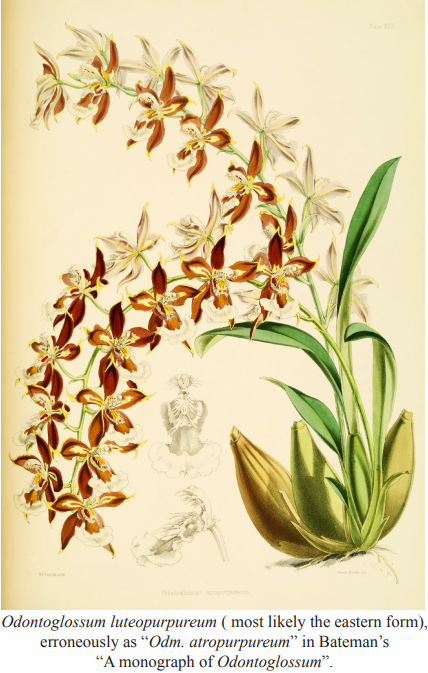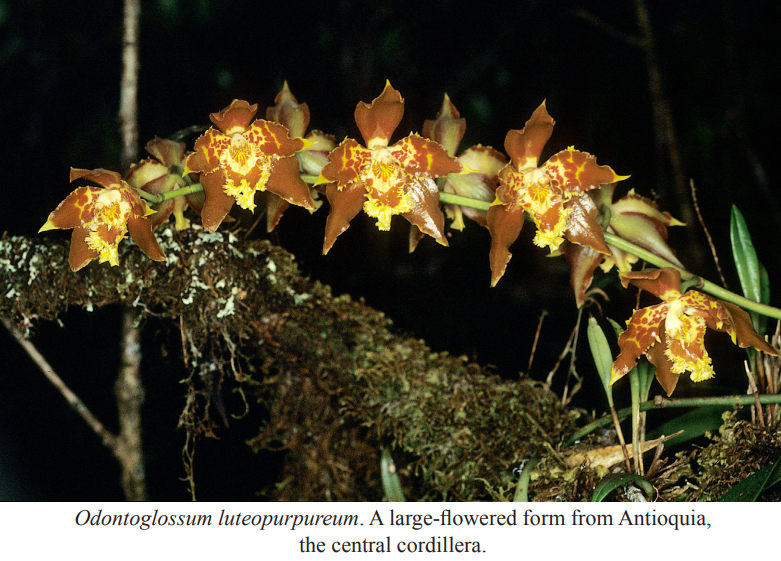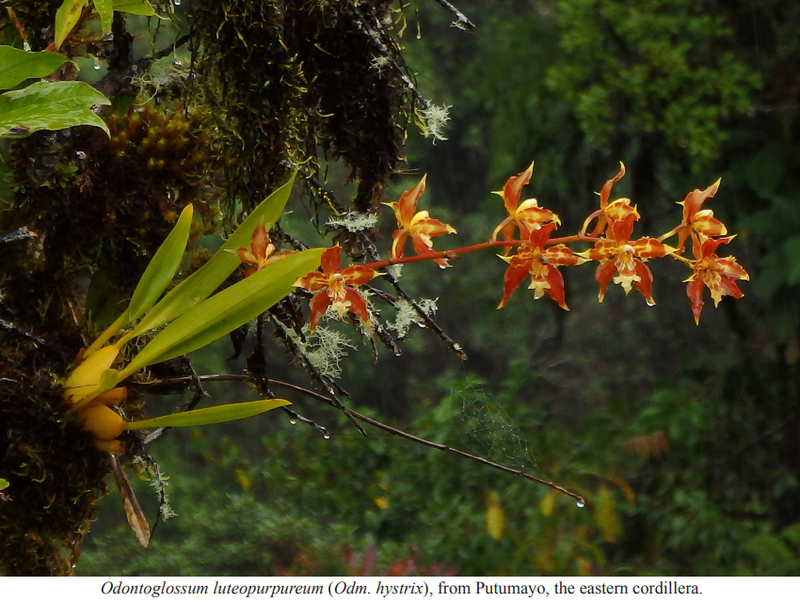Odontoglossum luteopurpureum Lindl., is really a widely distributed and variable complex, or “superspecies”, that due to geographic isolation in some areas have developed a degree of sub-speciation, which makes taxonomic handling rather difficult and sometimes controversial. Odontoglossum luteopurpureum  also tends to hybridize naturally with several other sympatric species, which makes the picture even more blurry. It may therefore be preferable to have a broader and more tolerant species concept in this particular case, unless you really want to punish yourself and the world by opening the “Pandora’s Box” filled with indefinable “sub-taxa”. Plants of Odm. luteopurpureum were first collected and brought to Europe by Jean Linden during his third expedition to the New World tropics in 1841–1844. He collected the type plant in February 1843, somewhere in the deep forests of Quindío at about 2600–2700 m, along the central cordillera in Colombia. A dried specimen was sent to John Lindley at Kew who described it in Orchidaceae Lindenianae (1846), and again in Folia Orchidacea (1852). Lindley chose the name based on what he interpreted as the yellow and purple colors of the flowers. No flowers of this species have since shown any purple coloration on the sepals and petals other than as an ingredient in the brown spots and blotches, which often covers much of the flower segments. Due to the high variability of the flowers of this species it was subsequently described under different names by several different authors. These names have since commonly been treated as synonyms, or as natural hybrids, except for Odm. sceptrum Rchb.f. & Warsz., which is still recognized by many as a distinct species. That is not correct, however, and the reason why is explained here.
also tends to hybridize naturally with several other sympatric species, which makes the picture even more blurry. It may therefore be preferable to have a broader and more tolerant species concept in this particular case, unless you really want to punish yourself and the world by opening the “Pandora’s Box” filled with indefinable “sub-taxa”. Plants of Odm. luteopurpureum were first collected and brought to Europe by Jean Linden during his third expedition to the New World tropics in 1841–1844. He collected the type plant in February 1843, somewhere in the deep forests of Quindío at about 2600–2700 m, along the central cordillera in Colombia. A dried specimen was sent to John Lindley at Kew who described it in Orchidaceae Lindenianae (1846), and again in Folia Orchidacea (1852). Lindley chose the name based on what he interpreted as the yellow and purple colors of the flowers. No flowers of this species have since shown any purple coloration on the sepals and petals other than as an ingredient in the brown spots and blotches, which often covers much of the flower segments. Due to the high variability of the flowers of this species it was subsequently described under different names by several different authors. These names have since commonly been treated as synonyms, or as natural hybrids, except for Odm. sceptrum Rchb.f. & Warsz., which is still recognized by many as a distinct species. That is not correct, however, and the reason why is explained here.
Odontoglossum sceptrum was based on a collection by Josef von Rawiez Warszewicz (No. 37, sheet 48124-W) and described by him together with Heinrich Gustav Reichenbach filius (1854a). There are six inflorescences of various lengths mounted on this particular sheet. An isotype in the herbarium at Kew has two separate inflorescences carrying flowers of different sizes. The locality given on a label mounted on the type sheet says “Central America”, which I cautiously interpret here as “Central Cordillera”, since that is where what is known as “Odm. sceptrum” occurs today. It is assumed by us that Warszewicz collected these specimens somewhere in the department of Antioquia, but it is also possible that the collection was made farther to the south and in the department of Tolima. We simply don’t know for sure. When comparing the type flowers of Odm. sceptrum with the type flowers of Odm. luteopurpureum, however, they appear so similar that the logical conclusion is that they represent the same taxon.

Leonore Bockemühl (1989) treats Odm. sceptrum as distinct from Odm. luteopurpureum based on a 12 mm long column, versus “18–20 mm” for Odm. luteopurpureum (Bockemühl, 1989). When the columns on the type specimens of Odm. luteopurpureum (Linden 1284) and Odm. sceptrum (Warszewicz 37) are measured, however, we find that they are 12–14 mm long for both taxa. We have to keep in mind here that they both most certainly came from the central cordillera and as the crow flies, probably not that far from each other. So where does the longer measurement come from? It turns out that plants from the eastern cordillera to this day have been erroneously treated as “typical” Odm. luteopurpureum, and they appear to have a longer column, ca 18–20 mm (excluding the anther). This is most likely what Bockemühl referred to in her treatment. Perhaps this subtle mistake is behind why Reichenbach described Odm. sceptrum as a distinct species in the first place? He may have compared it with plants from the eastern cordillera, which most likely were commonly seen in cultivation at the time.
This appears to be the main reason why the name “Odontoglossum sceptrum” still is used for plants from the central cordillera, and plants from the eastern cordillera are considered as “typical” luteopurpureums. If we decide to treat the form(-s) of this variable taxon from the eastern cordillera as distinct from the typical Odm. luteopurpureum, based on a longer column primarily (hence following Bockemühl but in a reversed order), we probably need to select another name from the list of already published but considered synonymous epithets. This is not something I am willing to do at this point for a variety of reasons, mainly due to a lack of understanding of how the various populations of this taxon in general may differ from each other. It is therefore safer to lump them together as a “superspecies” until more specific information is available. If we still decide that it is justified to treat plants from the eastern cordillera in Colombia as a distinct species, separate from the typical Odm. luteopurpureum (alias Odm. sceptrum), and use the oldest validly published name, then Odm. hystrix Bateman would probably be it. James Bateman writes in the original description: “Habitat in montibus prope Santa Fé de Bogota, 8-9000 ped.—Weir.”, “This is another of Weir’s remarkable discoveries in the vicinity of Bogota.” (Bateman, 1864). So we can assume that this plant came from the eastern cordillera.


In support of a “super-species” concept, however, Bateman (1874) writes in his “A Monograph of Odontoglossum”: “The vicissitudes which the name of this species has had to undergo within the last three years are full of instruction both to botanists and the public. It was first described by Lindley from wild specimens gathered by Linden in the neighbourhood of Quindio. Mr. Weir was the next to meet with it, and he succeeded in sending to the Horticultural Society several living plants that had been obtained about 100 miles to the south of Bogotá. He also sent wild specimens in admirable condition which, not agreeing with Lindley’s description, and being profusely furnished both at the base of the lip and in the apex of the column with long bristle-like appendages, led to my calling it O. hystrix (i. e. the Porcupine Odontoglossum). Messrs. Low also received the plant, through their collector Mr. Blunt, from the same locality as that where Weir met with it, and one of their plants produced flowers which—neither agreeing with Lindley’s O. luteo-purpureum nor with my O. hystrix—received from Professor Reichenbach the name of O. radiatum. Subsequently many specimens flowered, no two of which were alike, though they all maintained a sort of distant family resemblance to O. luteo-purpureum of which—as the Professor himself was the first to point out—there can now be no doubt that they are all varieties.”

As pointed out by Bateman, Reichenbach eventually realized that something was questionable with the current classification and therefore “sank” Odm. sceptrum into a “variety” of Odm. luteopurpureum in Xenia Orchidacea (1874). Later he back-pedaled somewhat when he wrote about Odm. sceptrum in Gardener’s Chronicle: “When degrading this fine thing to a variety of luteopurpureum, I may have been guided by some hybrids between the two varieties or species. At all events, it well deserves to rank as a distinct garden form. It is very fine in its clear colours, finest dark-lemon yellow, with well marked blackishpurple rich spots—no hue of that light copper colour one is tired of seeing.” (Reichenbach, 1882). The color description of “well marked blackish-purple rich spots” sounds strange for this taxon and is unknown to me. The flower that Reichenbach described so vividly was sent by James O’Brien, who in turn had received it from a R. P. Percival, of Clevelands, Lancashire. No specimen that matches this description has been identified in the herbarium of the Museum of Natural History in Vienna, Austria, where Reichenbach’s preserved collection is deposited, or elsewhere by me. Bockemühl (1989) cites Odontoglossum schlimii Linden & Rchb.f., as a synonym of “Odm. sceptrum” (= Odm. luteopurpureum) in her treatment. This is only half-true as we will see when we examine this case more closely. Odontoglossum schlimii was described in 1854 by Reichenbach and is based on a collection by Louis-Joseph Schlim, at ca. 2300–2600 m elevation in the forests near Ocaña, Colombia (Reichenbach, 1854b). The type specimen (Schlim 405, W) consists of a single unifoliate pseudobulb and a short inflorescence carrying the scars of three flowers of which only one remains (sheet 48465, W). A second specimen of the same collection (isotype) can be seen on sheet 48398 (W), where one flower remains on the inflorescence and one in an envelope mounted above it. When a close analysis is made of these flowers, it becomes clear that Odm. schlimii is the same as Odm. tripudians Rchb.f., also described by Reichenbach in Bonplandia 1854, but 78 pages earlier, which therefore takes nomenclatural priority. Bockemühl’s treatment of O. schlimii as a synonym of “Odm. sceptrum” may be based on a couple of Gustav Wallis’ collections (W), which were originally labeled “Odm. schlimii”, but re-determined as “Odm. sceptrum” by Bockemühl. These specimens do not represent the type of Odm. schlimii, however, and are quite different from the Schlim 405 specimens. I have only seen a single collection of Odm. luteopurpureum from the Ocaña area, but several collections of Odm. tripudians, so the latter species seems to be more common there. Why Reichenbach did not recognize the similarity between the types of Odm. schlimii and Odm. tripudians is puzzling. Perhaps it can be explained by the fact that the original locality for Odm. tripudians was believed to be “Peru”, which certainly is a mistake. No collections of anything similar to Odm. tripudians have ever been documented from Peru or Ecuador to my knowledge.
Stig Dalström
2304 Ringling Boulevard, unit 119, Sarasota FL 34237, USA
Lankester Botanical Garden, University of Costa Rica, Cartago, Costa Rica
National Biodiversity Centre, Serbithang, Bhutan
[email protected]; www.wildorchidman.com
Literature cited
Bockemühl, L. 1989. Odontoglossum, Monographie und Ikonographie - a Monograph and Iconograph. Brücke-Verlag Kurt Schmersow, D-3200 Hildesheim, Germany.
Bateman, J. 1864. Odontoglossum hystrix. New Plants (282). Gard. Chron.: 1202.
____. 1874. Odontoglossum hystrix. A monograph of Odontoglossum, sub. Pl. 17 [erroneously labeled “Odontoglossum atropurpureum”]. L. Reeve & Co., 5, Henrietta Street, Covent Garden. 1874. UK.
Lindley, J. 1846. Orchidaceae Lindenianae. Bradbury and Evans, Printers, Whitefriars, London, UK.
____. 1852. Odontoglossum. Folia Orchidacea part 1. J. Matthews, 5 Upper Wellington Street, Covent Garden, London. UK.
Reichenbach, H. G. fil. 1854a. Odontoglossum sceptrum. Julius [sic: Josef] von Warscewicz; Orchideae Warscewiczianae recentiores. Bonplandia 2(8): 99.
____. 1854b. Odontoglossum schlimii. Orchidiae Schlimianae. Bonplandia 2(23): 278 – 279.
____. 1874. Odontoglossum schlimii sub. sp. O. cuspidatum. Xenia Orch. 2: 194.
____. 1882. Odontoglossum sceptrum. New Garden Plants.Gard. Chron. 2(17): 525.
 Photography credit: Stig Dalström
Photography credit: Stig Dalström